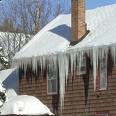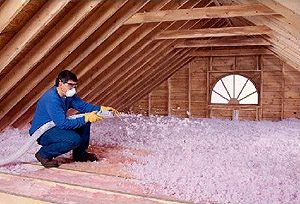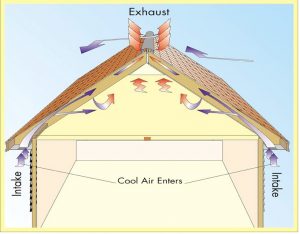 In our last article we discussed how an insufficient or worn out snow retention system (snow guards) can prevent snow from avalanching down your roof creating havoc to your roof and gutters. This article will discuss ice dams and ventilation.
In our last article we discussed how an insufficient or worn out snow retention system (snow guards) can prevent snow from avalanching down your roof creating havoc to your roof and gutters. This article will discuss ice dams and ventilation.
What Are Ice Dams?
The number two contributor to gutter damage is ice dams. Anyone who has lived in a snowy climate has seen ice dams. Thick bands of ice form along the eaves of houses, causing millions of dollars of structural damage every year. Water-stained ceilings, dislodged roof shingles or slates, sagging gutters, peeling paint, and damaged plaster–all are the familiar results of ice dams.
Contrary to popular belief, gutters do not cause ice dams. However, gutters do help to concentrate ice and water in the very vulnerable area at the edge of the roof.
Ice dams form along the roof’s edge, usually above the overhang.
Here’s why.
- Heat and warm air leaking from the living space below melt the snow, which trickles down to the colder edge of the roof (above the eaves) and refreezes.

- Every inch of snow that accumulates on the roof insulates the roof deck a little more. This keeps more heat in the attic, which in turn makes the roof even warmer and melts more snow.
- Frigid outdoor temperatures ensure a fast and deep freeze at the eaves. The worst ice dams usually occur when a deep snow is followed by very cold weather.
- The continual thaw and re-freeze process creates ice dams.
- The result is water backing up under the roof slate/shingles or behind fascia boards where it can soak through the roof decking or wall sheathing, causing damage to attics, ceilings and walls.
Solving the Ice Dam Problem
The way to stop ice dams from forming is to keep the entire roof cold. In most homes this means blocking all air leaks leading to the attic from the living space below, increasing the thickness of insulation on the attic floor, and installing a continuous soffit and ridge vent system.
Don’t waste time or money placing electric heat tape on the shingles above the edge of the roof. Electrically heated cable rarely, if ever, solves the problem. It takes a lot of electricity to prevent ice formation; and the heating must be done before it gets cold enough for ice dams to form, not afterwards. Over time, heat tape makes shingles brittle. It’s expensive to install, too, and water can leak through the cable fasteners. And often the cables create ice dams just above them.
The worst of all solutions is shoveling snow and chipping ice from the edge of the roof. People attack mounds of snow and roof ice with hammers, shovels, ice picks, homemade snow rakes, crowbars, and chain saws! The theory is obvious. No snow or ice, no leaking water. Unfortunately, this method threatens life, limb, and roof.
Insulation
 If your home was built before 1980, chances are it needs more attic insulation. Most homes in the Baltimore area have roughly 6” of insulation that equates to an R value of R-19. In the Baltimore metro area R-49 or 18” is recommended.
If your home was built before 1980, chances are it needs more attic insulation. Most homes in the Baltimore area have roughly 6” of insulation that equates to an R value of R-19. In the Baltimore metro area R-49 or 18” is recommended.
Ventilation
The second thing to look for in your attic is the amount of ventilation that you have. It is important to have ventilation in the attic so any heat lost from the interior of the home is drawn up and out of the attic.  Adequate attic ventilation will help the roof deck stay cool. Another benefit of having your attic ventilated is that it allows for moisture that rises into the attic from things such as bathing, cooking and the laundry to escape. Unchecked moisture can promote mold, mildew, and wood rot.
Adequate attic ventilation will help the roof deck stay cool. Another benefit of having your attic ventilated is that it allows for moisture that rises into the attic from things such as bathing, cooking and the laundry to escape. Unchecked moisture can promote mold, mildew, and wood rot.


From a client in Baltimore, MD
Area Of Satisfaction